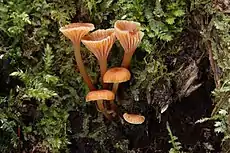Xeromphalina campanella
Xeromphalina campanella is a species of mushroom. The common names of the species include the golden trumpet and the bell Omphalina. The genus name Xeromphalina means "little dry navel" and campanella means "bell-shaped", respectively describing the mature and young shapes of the pileus, or cap.[2] The mushroom is also called fuzzy-foot.[3]

| Xeromphalina campanella | |
|---|---|
 | |
| Scientific classification | |
| Kingdom: | |
| Phylum: | |
| Class: | |
| Order: | |
| Family: | |
| Genus: | |
| Species: | X. campanella |
| Binomial name | |
| Xeromphalina campanella | |
Description
The fruit body of X. campanella has a small umbrella-shaped cap, about .5–2 cm wide.[4] The thin brown stalk is 1–5 cm long and 1–3 mm wide, yellow at the apex, reddish brown below, with brown or yellow hairs at the base.[4][5] The gills are pale yellow to pale orange.[4] The spore print is pale buff.[5] When the species is young, their caps are bell-shaped. As they mature, the outer part of the cap expands and rises which leaves the center depressed, resembling a navel.[6]
Edibility
Although the species is not poisonous,[2] the mushrooms are small and bitter tasting with no value as edibles.[6][7] David Arora suggests that the mushroom is a small morsel that is hardly worth eating.[8] Despite many authors calling the mushroom inedible, author Bill Russell knows people that eat the mushroom frequently.[9]
Habitat
The fruiting occurs in clumps or very dense clusters on decaying logs, stumps, and woody debris of coniferous trees. The species is commonly found in North America.[5] At times, the species almost entirely covers old tree stumps.[2] The species can be found in any wet season of the year.[6]
Similar species
| Xeromphalina campanella | |
|---|---|
| Gills on hymenium | |
| Cap is convex or depressed | |
| Hymenium is decurrent | |
| Stipe is bare | |
| Spore print is white | |
| Ecology is saprotrophic | |
| Edibility is unknown or inedible | |
Xeromphalina campanelloides is distinguishable via microscopic features.[10] Xeromphalina kauffmanii resembles the species, but has a more yellow cap[10] and grows on decaying wood of broad-leaved trees.[2] Xeromphalina brunneola also resembles the species, but has smaller, narrowly elliptical spores, and differs in odor, taste, and cap color.[11] Xeromphalina cauticinalis, X. cornui, and X. fulvipes are also similar.[10]
References
- "Xeromphalina campanella". Mycobank. Retrieved 21 December 2015.
- C. Roody, William (2003). Mushrooms of West Virginia and the Central Appalachians. University Press of Kentucky. p. 124. ISBN 978-0-8131-9039-6.
- G. Cassidy, Frediric (1991). Dictionary of American Regional English: D - H, Volume 2. Harvard University Press. ISBN 978-0-674-20511-6.
- Davis, R. Michael; Sommer, Robert; Menge, John A. (2012). Field Guide to Mushrooms of Western North America. Berkeley: University of California Press. p. 170. ISBN 978-0-520-95360-4. OCLC 797915861.
- McKnight, Kent H.; McKnight, Vera B. (1998) [1987]. A Field Guide to Mushrooms: North America. Houghton Mifflin Harcourt. pp. 196, 270. ISBN 978-0395910900.
- Metzler, Susan and Van (1992). Texas mushrooms: a field guide. University of Texas Press. p. 150. ISBN 978-0-292-75125-5.
- Miller Jr., Orson K.; Miller, Hope H. (2006). North American Mushrooms: A Field Guide to Edible and Inedible Fungi. Guilford, CN: FalconGuide. p. 193. ISBN 978-0-7627-3109-1.
- Arora, David (1986). Mushrooms demystified: a comprehensive guide to the fleshy fungi. Ten Speed Press. pp. 634. ISBN 978-0-89815-169-5.
Clavariadelphus truncatus.
- Russel, Bill (2006). Field guide to wild mushrooms of Pennsylvania and the Mid-Atlantic. Penn State Press. p. 203. ISBN 978-0-271-02891-0.
- Trudell, Steve; Ammirati, Joe (2009). Mushrooms of the Pacific Northwest. Timber Press Field Guides. Portland, OR: Timber Press. pp. 132–133. ISBN 978-0-88192-935-5.
- Bessette, Alan (1995). Mushrooms of North America in color. Syracuse University Press. p. 93. ISBN 978-0-8156-0323-8.